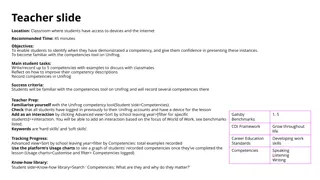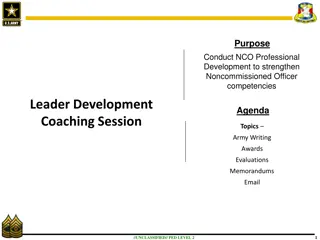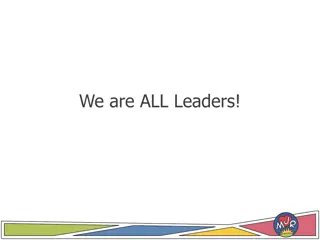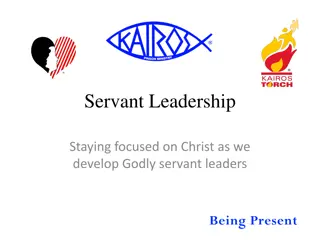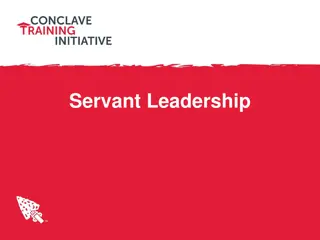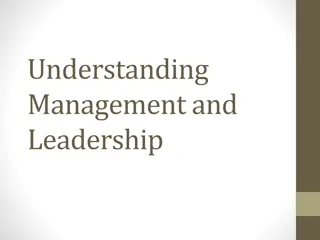Understanding Leadership Competencies: Types of Leaders and Activities
Explore the concept of leadership, identifying different types of leaders - Laissez-Faire, Autocratic, Democratic, and Paternalistic. Learn about their characteristics and how they handle various situations. Engage in group discussions and activities to practice different leadership styles, enhancing understanding and skill development.
Download Presentation

Please find below an Image/Link to download the presentation.
The content on the website is provided AS IS for your information and personal use only. It may not be sold, licensed, or shared on other websites without obtaining consent from the author. Download presentation by click this link. If you encounter any issues during the download, it is possible that the publisher has removed the file from their server.
E N D
Presentation Transcript
Teacher slide Objectives: To be able to understand what leadership is, ascertain when you have shown it and how you can improve it. You need: Student worksheet Computers (optional but highly recommended) Links to other resources: All the other competencies resources will be relevant for teaching alongside this one. We would encourage you to look at these in detail.
Unifrog resources Competencies: Leadership
Leadership The competencies section of the Unifrog platform allows you to list concrete examples of competencies, to support you in your future applications. A key competency employers and Universities favour is leadership. This competency is transferrable to numerous sectors and is complimentary to other competencies, including teamwork and communication. What makes a good leader? What makes a bad leader?
Leadership There are 4 main types of leadership Laissez-Faire leadership -The leader is a non-participant, who delegates nearly all responsibilities. -The leader is available if required. -Workers set their own objectives and tasks. -The decision-making process may take a long time or decisions may not be made at all. Autocratic leadership -Tasks or duties are set by the leader. -Communication is likely to be one-way from the top down. -The leader does not often become involved in the actual completion of tasks. -Work is always supervised. -The decision-making process is quick. Democratic leadership -Problems and potential solutions are discussed within the team. - Team members are encouraged to share ideas. -Objectives and tasks are agreed between the leader and team members before tasks are begun. -Communication is two-way. -Responsibility is often delegated to the team members during tasks and projects. -The decision making takes longer because of the greater number of people involved. Paternalistic leadership -The decision making process is in the hands of the leader. - The needs of the team members are listened to and they are encouraged to share ideas. -However, regardless of the views of the team members, the paternalistic leader will still decide what is best and what decision will be made.
Discussion In groups, discuss how you believe each style of leader would react to the situations below. A member of your team poses many ideas however, they clash with yours. An unforeseen circumstance has arisen on a very busy day. A member of your team seems reluctant to share ideas with the group.
Activity 1: instructions Working in small groups, one leader will be chosen. This leader will be given a problem which must be solved. The leader will also be told which leadership style they will conduct the activity in. The leader must stay in this role for the duration of the activity and must not tell the group which leadership style they are adopting.
Leadership There are 4 main types of leadership Laissez-Faire leadership -The leader is a non-participant, who delegates nearly all responsibilities. -The leader is available if required. -Workers set their own objectives and tasks. -The decision-making process may take a long time or decisions may not be made at all. Autocratic leadership -Tasks or duties are set by the leader. -Communication is likely to be one-way from the top down. -The leader does not often become involved in the actual completion of tasks. -Work is always supervised. -The decision-making process is quick. Democratic leadership -Problems and potential solutions are discussed within the team. - Team members are encouraged to share ideas. -Objectives and tasks are agreed between the leader and team members before tasks are begun. -Communication is two-way. -Responsibility is often delegated to the team members during tasks and projects. -The decision making takes longer because of the greater number of people involved. Paternalistic leadership -The decision making process is in the hands of the leader. - The needs of the team members are listened to and they are encouraged to share ideas. -However, regardless of the views of the team members, the paternalistic leader will still decide what is best and what decision will be made.
Activity 1: discussion -Which leadership style did your leader adopt? How do you know? -Did this leadership style work well for you? Why/why not? -Is there a place for all types of leadership style?
Activity 2: instructions In groups, draw a stick person on paper. Through group discussion, decide the qualities, behaviours and traits which make a good leader and write this on and around your person.
Activity 2: discussion What qualities are most important in a good leader? Is there just one type of good leader? Why/why not? What leaders have you seen in your life? When have you shown leadership?
Your competencies Login to the Unifrog platform and record examples of when you have displayed leadership. You might find this structure helpful when writing about your experiences. Situation: Set the scene Task: What was the task? Action: What did you do? Result: What was the outcome?
Your competencies For additional support, see the examples of how to define and write about different competencies. Consider examples from: school, extra curricular activities, volunteering and employment.
Sign in at: unifrog.org/student



